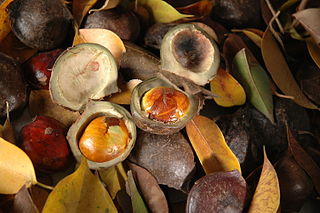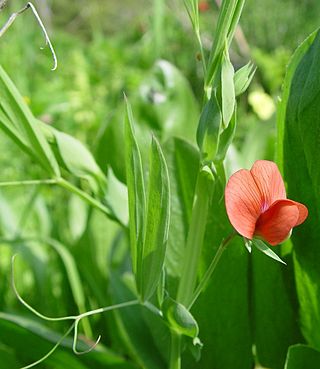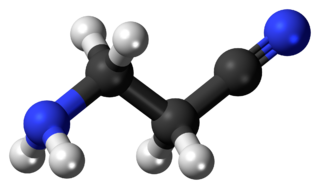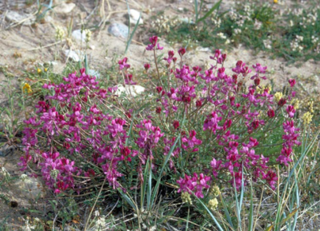
Lathyrus is a genus of flowering plants in the legume family Fabaceae, and contains approximately 160 species. Commonly known as peavines or vetchlings, they are native to temperate areas, with a breakdown of 52 species in Europe, 30 species in North America, 78 in Asia, 24 in tropical East Africa, and 24 in temperate South America. There are annual and perennial species which may be climbing or bushy. This genus has numerous sections, including Orobus, which was once a separate genus. The genus has numerous synonyms, including Pisum, the ancient Latin name for the pea.

Christopher Johnson McCandless, also known by his pseudonym "Alexander Supertramp", was an American adventurer who sought an increasingly nomadic lifestyle as he grew up. McCandless is the subject of Into the Wild, a nonfiction book by Jon Krakauer that was later made into a full-length feature film.

Lathyrus sativus, also known as grass pea, cicerchia, blue sweet pea, chickling pea, chickling vetch, Indian pea, white pea and white vetch, is a legume commonly grown for human consumption and livestock feed in Asia and East Africa. It is a particularly important crop in areas that are prone to drought and famine, and is thought of as an 'insurance crop' as it produces reliable yields when all other crops fail. The seeds contain a neurotoxin that causes lathyrism, a neurodegenerative disease, if eaten as a primary protein source for a prolonged period.

Into the Wild is a 1996 non-fiction book written by Jon Krakauer. It is an expansion of a 9,000-word article by Krakauer on Chris McCandless titled "Death of an Innocent", which appeared in the January 1993 issue of Outside. The book was adapted to a film of the same name in 2007, directed by Sean Penn with Emile Hirsch starring as McCandless. Into the Wild is an international bestseller which has been printed in 30 languages and 173 editions and formats. The book is widely used as high school and college reading curriculum. Into the Wild has been lauded by many reviewers, and in 2019 was listed by Slate as one of the 50 best nonfiction works of the past quarter-century.

Vicia is a genus of over 240 species of flowering plants that are part of the legume family (Fabaceae), and which are commonly known as vetches. Member species are native to Europe, North America, South America, Asia and Africa. Some other genera of their subfamily Faboideae also have names containing "vetch", for example the vetchlings (Lathyrus) or the milk-vetches (Astragalus). The lentils are included in genus Vicia, and were formerly classified in genus Lens. The broad bean is sometimes separated in a monotypic genus Faba; although not often used today, it is of historical importance in plant taxonomy as the namesake of the order Fabales, the Fabaceae and the Faboideae. The tribe Vicieae in which the vetches are placed is named after the genus' current name. The true peas (Pisum) are among the closest living relatives of vetches.

Lathyrus japonicus, the sea pea, beach pea, circumpolar pea or sea vetchling, is a species of flowering plant in the legume family Fabaceae, native to temperate coastal areas of the Northern Hemisphere, and Argentina.
Lytico-bodig (also Lytigo-bodig) disease, Guam disease, or amyotrophic lateral sclerosis-parkinsonism-dementia (ALS-PDC) is a neurodegenerative disease of uncertain etiology endemic to the Chamorro people of the island of Guam in Micronesia. Lytigo and bodig are Chamorro language words for two different manifestations of the same condition. ALS-PDC, a term coined by Asao Hirano and colleagues in 1961, reflects its resemblance to amyotrophic lateral sclerosis (ALS), Parkinson's disease, and Alzheimer's disease.

β-Methylamino-L-alanine, or BMAA, is a non-proteinogenic amino acid produced by cyanobacteria. BMAA is a neurotoxin. Its potential role in various neurodegenerative disorders is the subject of scientific research.
Osteolathyrism, sometimes referred to as odoratism, is a form of the disease Lathyrism. The disease results from the ingestion of Lathyrus odoratus seeds. The toxin found in the sweet peas is (beta-aminopropionitrile), which affects the linking of collagen, a protein of connective tissues. The condition results in damage to bone and mesenchymal connective tissues. Osteolathyrism occurs in people in combination with neurolathyrism and angiolathyrism in areas where famine demands reliance on a crop with known detrimental effects. It occurs in cattle and horses with diets overreliant upon the grass pea. Prominent symptoms include skeletal deformities and bone pain.

Oxalyldiaminopropionic acid (ODAP) is a structural analogue of the neurotransmitter glutamate found in the grass pea Lathyrus sativus. It is the neurotoxin responsible for the motor neuron degeneration syndrome lathyrism.

Archidendron pauciflorum, commonly known as djenkol, jengkol or jering is a species of flowering tree in the pea family, Fabaceae. It is native to Southeast Asia, where the seeds are a popular dish. They are mainly consumed in Indonesia, Thailand, Myanmar, and Vietnam, prepared by frying, boiling, or roasting, and eaten raw. The beans are mildly toxic due to the presence of djenkolic acid, an amino acid that causes djenkolism. The beans and leaves of the djenkol tree are traditionally used for medicinal purposes such as purifying the blood. To date, djenkol is traded on local markets only.

Gachas is an ancestral basic dish of central and southern Spain. It is a gruel whose main ingredients are flour, water, olive oil, garlic, paprika and salt.

Lathyrus cicera is a species of wild pea known by the common names red pea, red vetchling and flatpod peavine. It is native to Europe, North Africa, and the Middle East, and it is known from other places as an introduced species. This is a hairless annual herb producing a slightly winged stem. The leaves are each made up of two leaflike linear leaflets 3 to 6 centimeters long. They also bear branched, curling tendrils. The inflorescence holds a single pea flower 1 to 1.5 centimeters wide which is a varying shade of red. The fruit is a hairless dehiscent legume pod.

Aminopropionitrile, also known as β-aminopropionitrile (BAPN), is an organic compound with both amine and nitrile functional groups. It is a colourless liquid. The compound occurs naturally and is of interest in the biomedical community.
Divicine (2,6-diamino-4,5-dihydroxypyrimidine) is an oxidant and a base with alkaloidal properties found in fava beans and Lathyrus sativus. It is an aglycone of vicine. A common derivative is the diacetate form (2,6-diamino-1,6-dihydro-4,5-pyrimidinedione).
Angiolathyrism is a form of Lathyrism disease. It is mainly caused the consumption of Lathyrus sativus and to a lesser degree by Lathyrus cicera, Lathyrus ochrus and Lathyrus clymenum containing the toxin ODAP. The main chemical responsible is β-Aminopropionitrile, which prevents collagen cross-linking, thus making the blood vessel, especially the tunica media, weak. This can result in Cystic medial necrosis or a picture similar to Marfan syndrome. The damaged vessels are at an increased risk of dissection.

Hedysarum alpinum is a species of flowering plant in the legume family known by the common name alpine sweetvetch. It is called masu in the Iñupiaq language. It has a circumpolar distribution, occurring throughout the northern latitudes of the Northern Hemisphere. In North America it is widespread in Canada and the northernmost United States, including Alaska.
Perdur Radhakantha Adiga was an Indian endocrine biochemist, reproductive biologist, INSA Senior Scientist and an Astra chair professor of the Indian Institute of Science. He was known for his researches on vitamin-carrier proteins and Lathyrus sativus and was an elected fellow of the Indian Academy of Sciences and the Indian National Science Academy. The Council of Scientific and Industrial Research, the apex agency of the Government of India for scientific research, awarded him the Shanti Swarup Bhatnagar Prize for Science and Technology, one of the highest Indian science awards for his contributions to Medical Sciences in 1980.
Lathyrism is a condition caused by eating certain legumes of the genus Lathyrus. There are three types of lathyrism: neurolathyrism, osteolathyrism, and angiolathyrism, all of which are incurable, differing in their symptoms and in the body tissues affected.
Lathyrism is a class of neurological disease of humans.














